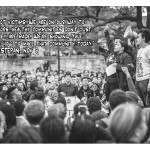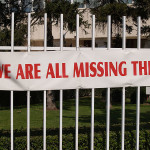by Micah Jones
I call November 5th, 2015 “Dark Thursday.” I remember standing on Cross Campus with friends who have become family talking to Dean Holloway with tears and raindrops running in intermingling rivets down our faces. We told him that we needed more from him, from President Salovey, from this university, from our peers. We told them that being second class students at a first class university was not enough.
On Wednesday, April 27th, we opened yet another email from the Yale administration letting us know how little they think we are worth. Pauli Murray College is a step in the right direction, but when paired with Benjamin Franklin College, when paired with the decision to keep Calhoun’s name, it is not enough. And I am tired.
The events on this campus over the last four years are not isolated, but rather a part of a larger story of what students of color have experienced in our time here. It is all a part of one swelling tidal wave of racism that began washing over me in my senior year of high school with the death Trayvon Martin.
In the summer of 2014, I watched as Eric Garner became horribly still in the embrace of the New York police. I saw the images of Michael Brown’s body frying on the asphalt in the midday sun. I saw the police invade Black neighborhoods rolling down the streets in tanks and wearing gas masks. On this very campus, a Yale student was held at gunpoint by the police. Yet, in asking that we not have to live in a college named after one of the foremost proponents of slavery as a positive good in American history, we are asking for too much.
There comes a point, or maybe many points, in every student of racism’s life when they begin to truly understand the scale of the problem they are facing. What I have lost in my time here is the belief that racism and monuments that honor racists will be excised from this campus in my time here as a student or this nation within my lifetime. This loss of faith raises the question: why should I fight these battles if I may never win?
Time and time again, I turn to the past in search of a legacy, a usable history that might offer insight into my present conundrum. I frequently return to the narrative of Myles Horton. Horton was a lifelong activist for racial and economic justice and founder of the Highlander Folk School which taught grassroots organizing. Horton published a book called “The Long Haul.”
In “The Long Haul,” Horton uses a burning log fire as an extended metaphor about maintaining one’s passion for activism. He argued that in order to make it in the long-term an activist has to learn to keep the fire of their passion banked, but smoldering, and ready to flare up when needed. Given how deeply entrenched various systems of oppression were in American society, liberation was not going to end overnight but rather “the revolution had to be built step by step.”
“The Long Haul” teaches us that we must take things day by day. This way we are not overwhelmed.
We must remember the bigger picture – that racism affects every aspect of our lives both on and off campus, but we must not let it consume us. We must cherish the victories, and not let them be used to pacify us, but rather to remind us of our power. We must pace ourselves if we are going to be in it for the long haul.
There are still days, like today, when being a Black woman on this campus curls me into the fetal position in the womb of my narrow twin bed. In these moments, I remember that this struggle is sacred. That I fight because I value myself and all of you people whom I love too much not to at least try. Every day that we take to our beds, and do not stay there, choose instead to be reborn, choose instead the struggle, choose instead to live on and fight on, we are victorious. To paraphrase Yale alumna Zora Howard in her poem “Sistergirlfriend,” we are a hundred miles deep, two thousand degrees, squeezed to bursting brilliance, we are a sharp darkness, we are a peeling stone, and we are more than enough.



